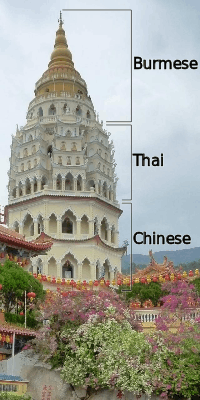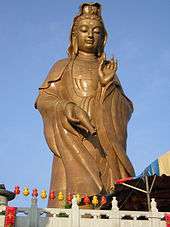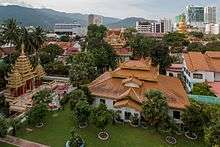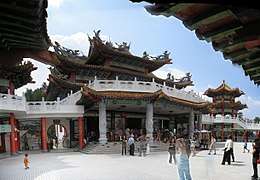Kek Lok Si
| Kek Lok Si | |
|---|---|
 | |
 Location in Air Itam, George Town | |
| Geography | |
| Coordinates | 5°23′58.29″N 100°16′25.43″E / 5.3995250°N 100.2737306°ECoordinates: 5°23′58.29″N 100°16′25.43″E / 5.3995250°N 100.2737306°E |
| Country | Malaysia |
| State | Penang |
| Locale | Air Itam |
| Location | George Town |
| Culture | |
| Sanctum | Buddha |
| Architecture | |
| Architecture | Chinese, Thai and Burmese |
| History | |
| Date built | 1904 |
| Creator | Beow Lean |
| Kek Lok Si | |||||||||||||
| Traditional Chinese | 極樂寺 | ||||||||||||
|---|---|---|---|---|---|---|---|---|---|---|---|---|---|
| Simplified Chinese | 极乐寺 | ||||||||||||
| Literal meaning | "Temple of Ultimate Happiness" | ||||||||||||
| |||||||||||||
The Kek Lok Si Temple is a Buddhist temple situated in Air Itam, Penang, Malaysia, facing the sea, and is one of the best known temples on the island. It is the largest Buddhist temple in Malaysia,[1] and also an important pilgrimage centre for Buddhists from Hong Kong, the Philippines, Singapore and other countries in Southeast Asia. The entire complex of temples was built over a period from 1890–1930, an inspirational initiative of Beow Lean, the Abbot. The main draw in the complex is the striking seven-storey Pagoda of Rama VI (Pagoda of Ten Thousand Buddhas) with 10,000 alabaster and bronze statues of Buddha, and the 36.57 metres (120.0 ft) tall bronze statue of Kuan Yin, the Goddess of Mercy.
Mahayana Buddhism, Theravada Buddhism and traditional Chinese rituals blend into a harmonious whole, both in the temple architecture and artwork as well as in the daily activities of worshippers.
Etymology
The literal meaning of Kek Lok Si Temple is "Heavenly temple", [2] "Pure Land Temple",[3] "Temple of Supreme Bliss",[4] and the "Temple of Paradise".[4]
History
The construction of the temple began in 1890[5] and completed in 1905. It was inspired by Beow Lean, the chief monk of the Goddess of Mercy Temple at Pitt Street in 1887; he had served earlier in the Kushan Abbey in Fujian in China. The site chosen by Beow, a spiritual location in the hills of Ayer Itam, facing the sea, was named "Crane Mountain". It was established as a branch of the Buddhist Vatican in Drum Mountain in Foochow in Hokkien province. Beow Lean was the first Abbot of the temple. The buildings of the temple complex were sponsored by five leading Chinese business people of Penang known as "Hakka tycoons". They were: Cheong Fatt Tze, his cousin Chang Yu Nan, Chea Choon Seng, Tye Kee Yoon, and Chung Keng Kooi. Collection of funds for building the temple was also facilitated by dedicating the structures and artefacts in the name of the temple's benefactors.[3][4][6][7] The main hall, which was completed first, housed a shrine to Guanyin, in a recessed area where many other female goddesses called the Queen of Heaven, the Goddess of the Earth, and Goddess of Childbirth are housed; which is said to represent, on a miniature scale, the island of Potalaka where there is a large shrine dedicated to Guanyin in the China Sea. People compared this shrine to the Amitabha Buddha's Western Paradise and started calling it the "Kek Lok Si" ("Jile Si"). There are also many other shrine chambers, which have stately statues, all gilded, of the Buddhas, Bodhisattvas, saintly Lohans, guardian spirits, and Heavenly (or Diamond) Kings of Pure Land Buddhism.[8]
The consular representative of China in Penang reported the grandeur of the temple to the Qing Government. Following this, the Guangxu Emperor invited Beow Lean to Beijing in 1904 and bestowed on him, 70,000 volumes (7,000 is also mentioned in some references) of the "psalms and other sacred works of Buddhism" and also presented him edicts anointing him as "dignity of the Chief Priest of Penang" and also declaring "the Chinese temple at Air Itam as the head of all Chinese temples in Penang".[3][4] On the Abbot's return to Penang, a royal procession, carrying the edict in a rattan chair and the scriptures in pony driven carts, was organised leading to the temple complex. Prominent Chinese dignitaries of Penang in their royal mandarin attire accompanied the Abbot in the procession.[4]

In 1930, the seven storey main pagoda of the temple or the Pagoda of "Ban Po Thar", the Ten Thousand Buddhas, a 30 metres (98 ft) high structure, was completed. This pagoda combines a Chinese octagonal base with a middle tier of Thai design, and a Burmese crown (spiral dome); reflecting the temple's amalgam of both Mahayana and Theravada Buddhism.[5][9] It represents syncretism of the ethnic and religious diversity in the country. There is a large statue of Buddha donated by King Bhumibol of Thailand diefied here.[5][9] King Rama VI of Thailand laid the foundation for the pagoda and it is hence also named as Rama Pagoda.[10]

In 2002, a 30.2-metre (99 ft) bronze statue of Guanyin, the Goddess of Mercy, was completed and opened to the public. It replaced the previous white plaster Kuan Yin statue which was damaged due to a fire a few years earlier. The bronze statue is located on the hillside above the pagoda. The statue is complemented with a 60.9 metres (200 ft) three-tiered roof pavilion (with 16 columns made of bronze supporting the pavilion),[5] which was completed in 2009.[11] It is the tallest Guanyin statue in the world.[12] One hundred statues of the goddess Kuan Yin, each of 2 metres (6 ft 7 in) height, are set around the main statue of the goddess. However, its height was restricted to avoid its shadow falling on the Penang State Mosque.[13] This shrine also has other 10,000 statues of Buddha, apart from a statue of 12 Zodiac Animal Signs of the Chinese Calendar.[5]
The temple complex has a large hydraulically operated bell, which tolls with a high pitch at frequent intervals. Wood and stone carvings are profusely seen in the temple. In front of each deity there is a cushion, impressive scrolls, and candles set in very attractive suspended lamps, and with a large number of priests in attendance.[4]
Description

Kek Lok Si Temple is located at the foot of the Air Itam mountain in George Town on Penang Island. It is built over a plot of an area of 12.1 hectares (30 acres) that was donated by Yeoh Siew Beow. It is about 3 kilometres (1.9 mi) walk from the Penang Hill Station.[2][6]
Most visitors approach the temple as they ascend a stairway, roofs of which provide shelter to a multitude of shops selling souvenirs and other - mostly secular - commodities. They pass by a so-called Liberation Pond, following the Buddhist tradition of merit-making, turtles may be released into freedom, albeit a limited one.[6][7][14]
The temple itself consists of several large prayer halls and pavilions for assembly and prayer, statues of Buddha; various Bodhisattvas as well as Chinese gods are being venerated. The architectural features include carved pillars, fine woodwork, mostly painted in bright colours, and a plethora of lanterns add to the visual impression. Fish ponds and flower gardens are also part of the temple complex.[6]
There are two tiers of double-lane inclined elevators to carry pilgrims and visitors further uphill. An electric buggy service links the different tiers of elevators as their middle levels are some distance apart. On the elevated platform, there is a fish pond, and the towering statue of Kuan Yin, Goddess of Mercy which is worshipped by women to beget children.[5][14] The monks and nuns, who are housed in a monastery and who
Annual events
The temple is a focal point of festivals of the Chinese community in Penang. The Chinese New Year celebrations are particularly impressive. For 30 days following Chinese New Year, the temple remains open until late at night whilst thousands of lights turn the scenery into a sea of light. During the festival days, the complex is decorated with thousands of lanterns representing donations offered by devotees. Another festive feature is the long marches undertaken by hundreds of monks from Thailand to the temple, once or twice in a year.[7][15]
Worship

Worship of the deities in the temple complex reflects the diversity of the ethnic origins of the Buddhist devotees. Such worship could be in the form of counting prayer beads or by burning incense or by cash offerings or just by bowing and clapping to make one's presence known to the deity. Highly learned people offer prayers at the tower of Sacred Books in the upper part of the temple. Some pilgrims also offer prayers in the extensive gardens located in the precincts of the temple.[2]
The religious paraphernalia sold along the winding steps that lead to the temple precincts cater to the religious offerings to be made by the pilgrims. The goods on sale comprise ornaments, books, pictures, collection of sayings and strings of a sacred orange colour and mementos such as T-shirts and CDs.[9]
References
Notes
- ↑ Wendy Moore (1998). West Malaysia and Singapore. Tuttle Publishing. pp. 104–. ISBN 978-962-593-179-1.
- 1 2 3 Davidson & Gitlitz 2002, p. 313.
- 1 2 3 Khoo 2007, p. 37.
- 1 2 3 4 5 6 DeBernardi 2009, p. 33.
- 1 2 3 4 5 6 Harper 2006, p. 189.
- 1 2 3 4 Cheah 2013, p. 205.
- 1 2 3 Tourism Malaysia
- ↑ DeBernardi 2009, p. 32-33.
- 1 2 3 Davidson & Gitlitz 2002, p. 314.
- ↑ Neo 2014, p. 41.
- ↑ White, Emmons & Eveland 2011, p. 554.
- ↑ The Star 2014.
- ↑ Khoo 2006, p. 227.
- 1 2 Brockman 2011, p. 276.
- ↑ Khoo 2007, pp. 37–38.
Bibliography
- Brockman, Norbert (13 September 2011). Encyclopedia of Sacred Places. ABC-CLIO. ISBN 978-1-59884-654-6.
- Cheah, Jin Seng (19 February 2013). Penang 500 Early Postcards. Editions Didier Millet. ISBN 978-967-10617-1-8.
- Davidson, Linda Kay; Gitlitz, David Martin (1 January 2002). Pilgrimage: From the Ganges to Graceland : an Encyclopedia. ABC-CLIO. ISBN 978-1-57607-004-8.
- DeBernardi, Jean Elizabeth (2009). Penang: Rites of Belonging in a Malaysian Chinese Community. NUS Press. ISBN 978-9971-69-416-6.
- Harper, Damian (December 2006). Malaysia, Singapore & Brunei. Ediz. Inglese. Lonely Planet. ISBN 978-1-74059-708-1.
- Khoo, Gaik Cheng (1 January 2006). Reclaiming Adat: Contemporary Malaysian Film and Literature. UBC Press. ISBN 978-0-7748-1173-6.
- Khoo, Salma Nasution (2007). Streets of George Town, Penang. Areca Books. ISBN 978-983-9886-00-9.
- Neo, Kyle (1 May 2014). 108 Places To See Before Nirvana. PartridgeIndia. ISBN 978-1-4828-9734-0.
- "Kek Lok Si". Tourism Malaysia. Retrieved 22 May 2014.
- "Stand up for moderation". The Star Online. Retrieved 24 March 2015.
- White, Daniel; Ron, Emmons; Eveland, Jennifer; Jen Lin-Liu (9 June 2011). Frommer's Southeast Asia. John Wiley & Sons. ISBN 978-1-118-08767-1.
External links
| Wikimedia Commons has media related to Kek Lok Si Temple, Penang. |


%2C_Sentul%2C_Kuala_Lumpur.jpg)
